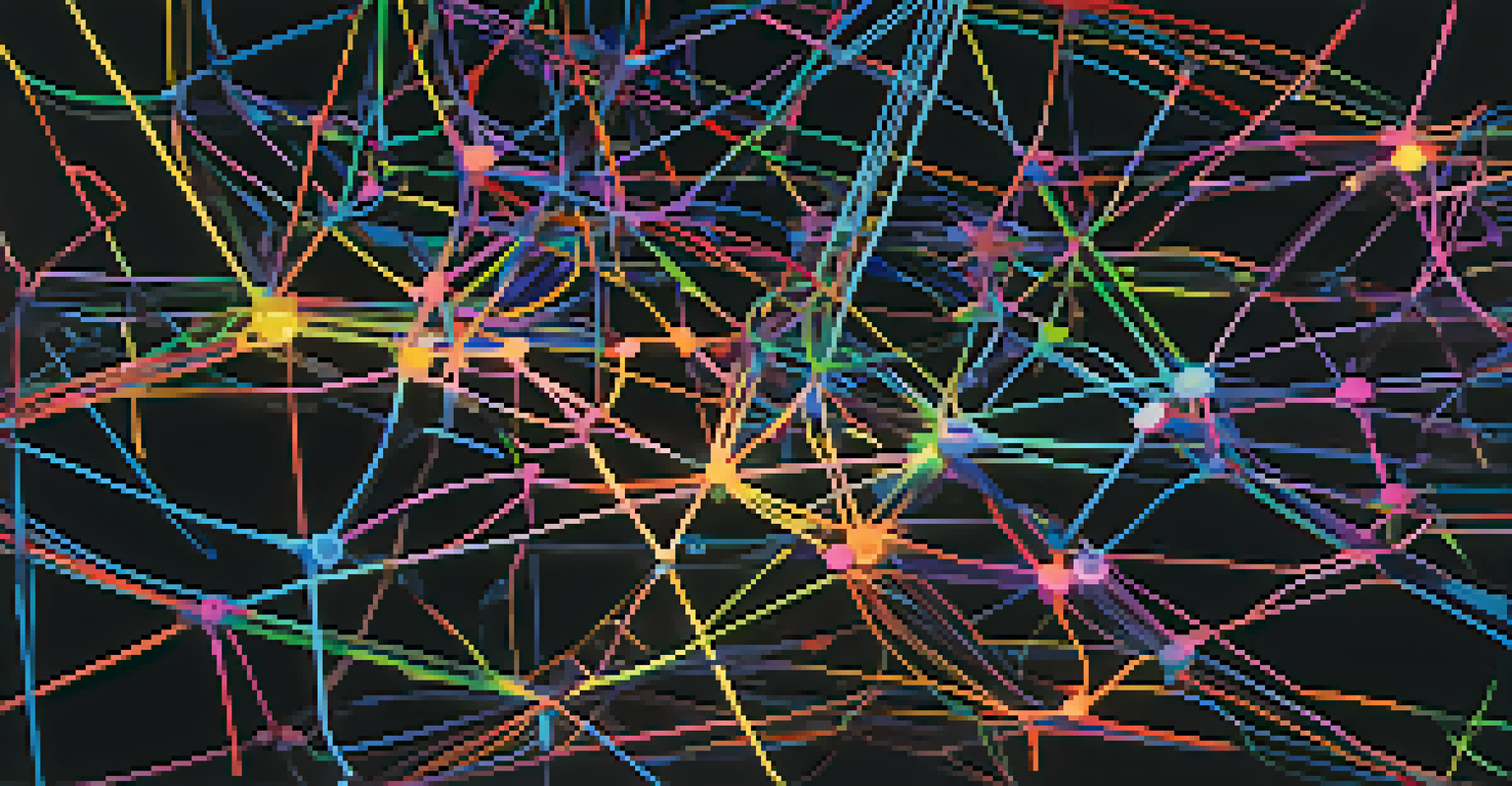Recurrent Neural Networks for Sequence Prediction Tasks

What Are Recurrent Neural Networks (RNNs)?
Recurrent Neural Networks, or RNNs, are a type of artificial neural network designed to recognize patterns in sequences of data. Unlike traditional neural networks, which treat each input independently, RNNs have loops that allow information to persist. This characteristic makes them particularly effective for tasks involving time series data, language processing, and more. Essentially, RNNs can remember previous inputs, which is crucial for understanding context in sequences.
The greatest value of a picture is when it forces us to notice what we never expected to see.
Imagine trying to predict the next word in a sentence. If you're reading 'The cat sat on the...', you instinctively know that 'mat' is a likely next word because of the context. RNNs function similarly; they take the context from previous inputs to make informed predictions about what comes next. This ability to connect the dots over time is what sets RNNs apart from other neural networks.
However, RNNs come with their own set of challenges, such as vanishing and exploding gradients. These issues can hinder their performance on long sequences. To address these, more advanced architectures like Long Short-Term Memory (LSTM) and Gated Recurrent Units (GRU) have been developed. These models are designed to effectively manage the flow of information, making them more robust for complex sequence prediction tasks.
How RNNs Work: The Basics
At the heart of an RNN is a simple concept: it processes data sequentially while maintaining a hidden state that captures information about previous inputs. This hidden state is updated at each time step, allowing the network to retain context. The process begins with an input vector, which is combined with the previous hidden state to produce a new hidden state that reflects both the current input and past information.

Think of this process like reading a book. Each page offers new information, but your understanding of the story builds upon what you've read previously. Similarly, RNNs use their hidden states to keep track of the narrative formed by incoming data. As they encounter new inputs, they adjust their understanding based on the history they’ve accumulated.
RNNs Recognize Sequential Patterns
Recurrent Neural Networks (RNNs) are designed to process sequences of data, allowing them to remember previous inputs and understand context.
This unique structure allows RNNs to perform well in various sequence prediction tasks, whether it's forecasting stock prices, translating languages, or even generating text. However, while the fundamental mechanism is straightforward, achieving optimal performance often requires careful tuning of hyperparameters and extensive training with large datasets to ensure the network learns effectively.
Applications of RNNs in Real Life
RNNs have a wide range of applications that leverage their ability to process sequential data. One prominent use case is in natural language processing (NLP), where RNNs can be employed for tasks such as sentiment analysis, language translation, and speech recognition. For instance, Google Translate utilizes RNNs to convert text from one language to another while preserving the intended meaning.
Without data, you're just another person with an opinion.
Consider how RNNs help in predictive text features on smartphones. When you type a message, the phone suggests the next word based on the context of what you've written so far. This functionality is powered by RNNs, which analyze the sequence of letters and words to make intelligent predictions. It’s a small but powerful example of how RNNs enhance user experience in daily communication.
Beyond language, RNNs are also valuable in finance for predicting stock movements based on historical data. They can analyze trends and patterns to make forecasts about future prices, helping traders make informed decisions. This versatility showcases the potential of RNNs across various sectors, making them a fundamental tool in the machine learning toolkit.
Challenges in Training RNNs
Training RNNs effectively can be quite challenging due to issues like vanishing gradients, where the influence of earlier inputs diminishes over time. This happens during backpropagation, where the gradients used to update weights can become extremely small. As a result, RNNs struggle to learn long-range dependencies, which are crucial for tasks that require understanding context over extended sequences.
Think of it like trying to remember a story you heard a long time ago. If key details fade from memory over time, it becomes difficult to recall the plot accurately. Similarly, RNNs can forget important information from earlier in a sequence, leading to suboptimal performance. This limitation is particularly pronounced in long sequences, where the model needs to retain information over many time steps.
LSTMs Enhance RNN Performance
Long Short-Term Memory (LSTM) networks improve RNNs by addressing the vanishing gradient problem, enabling them to retain relevant information over longer sequences.
To combat these challenges, researchers have developed specialized architectures like LSTMs and GRUs, which include mechanisms to control the flow of information. These advancements help mitigate the vanishing gradient problem and allow RNNs to remember relevant information for longer periods. Consequently, they improve the model's ability to make accurate predictions in sequence tasks.
Long Short-Term Memory (LSTM) Networks
LSTMs are a specific type of RNN designed to address the shortcomings of standard RNNs, particularly the vanishing gradient problem. They introduce a more complex architecture that includes memory cells, input gates, output gates, and forget gates. This design allows LSTMs to decide what information to keep or discard, enabling them to retain relevant context over longer sequences.
Consider LSTMs as a well-organized filing cabinet. Each drawer (or memory cell) can hold important documents (information) that the network needs to reference later. The gates act like diligent assistants, determining which documents to keep handy and which ones can be put away. This organizational strategy ensures that LSTMs can effectively manage information and make better predictions.
Thanks to their ability to capture long-range dependencies, LSTMs have been successfully applied in various domains, including music composition, image captioning, and even healthcare for predicting patient outcomes. Their robustness and versatility have made them a go-to solution for many sequence prediction challenges, establishing them as a cornerstone in the field of deep learning.
Gated Recurrent Units (GRU) Explained
Gated Recurrent Units (GRUs) are another variant of RNNs that aim to simplify the architecture while maintaining the ability to capture long-range dependencies. Similar to LSTMs, GRUs also use gating mechanisms to control the flow of information. However, they have a slightly different structure, combining the input and forget gates into a single update gate, which reduces the complexity of the model.
You can think of GRUs as a streamlined version of LSTMs, akin to a compact car that still gets you where you need to go efficiently. By simplifying the architecture, GRUs often require less computational resources while still providing strong performance in many sequence prediction tasks. This makes them an attractive choice for scenarios where efficiency is paramount.
GRUs Simplify RNN Architecture
Gated Recurrent Units (GRUs) streamline RNN designs, combining gating mechanisms to maintain performance while reducing computational complexity.
GRUs have gained popularity in various applications, particularly in NLP tasks like text generation and machine translation. Their ability to perform comparably to LSTMs while being less resource-intensive makes GRUs a valuable tool for developers looking to implement effective sequence models without compromising performance.
Future Trends in Sequence Prediction with RNNs
As technology continues to evolve, the field of sequence prediction is poised for exciting advancements. Researchers are exploring ways to enhance RNN architectures further, including integrating attention mechanisms that allow models to focus on specific parts of the input sequence. This approach can improve the model's performance by enabling it to weigh the importance of different inputs dynamically.
Imagine watching a movie where you can replay key scenes to better understand the plot. Attention mechanisms work similarly, helping RNNs concentrate on the most relevant parts of a sequence while processing information. This trend is already being integrated into models like Transformers, which have gained significant traction in NLP and other domains.

Moreover, as data availability increases, training RNNs on larger datasets will lead to even more robust models. The combination of better architectures, attention mechanisms, and abundant data will likely propel RNNs into new realms of sequence prediction, making them even more indispensable in applications ranging from autonomous vehicles to personalized recommendations.